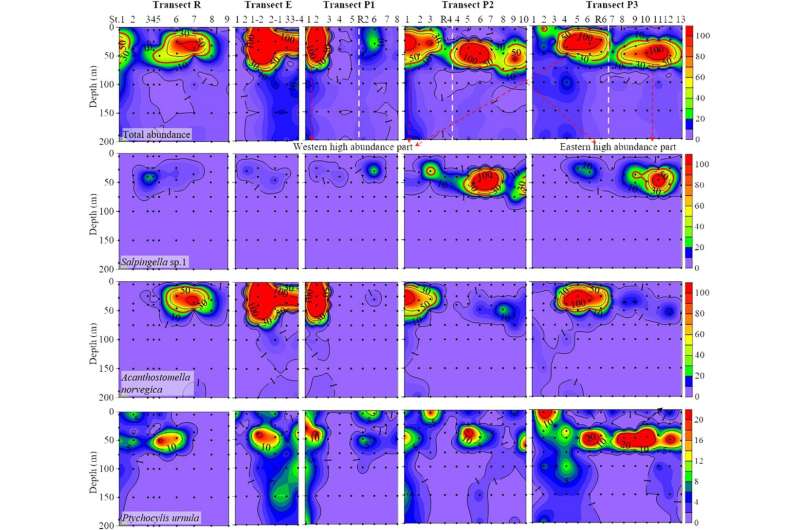Vertical distribution of total and abundant tintinnid abundance (ind. L– 1) from surface to 200 m. Black dots, sampling points. White dashed line, the boundary of western and eastern high abundance (≥30 ind. L– 1) part in transects P1, P2, and P3. Credit: DOI: 10.3389/fmars.2021.775653
Tintinnids are planktonic ciliates with loricae around their body. They are considered bioindicators of various oceanographic conditions.
The Arctic Ocean is one of the most sensitive regions to global warming. It contains complex water masses with unique hydrographic features and zooplankton communities.
Dr. Wang Chaofeng from Prof. Zhang Wuchang's team at the Institute of Oceanology of the Chinese Academy of Sciences (IOCAS) and his collaborators investigated the tintinnid community structure variations in different water masses of the Arctic Basin.
They found that Pacific-origin tintinnid invaded in the Canada Basin, revealing a rapid borealization progress of Arctic microzooplankton.
The study was published in Frontiers in Marine Science on Jan. 20.
Researchers found that five water masses occurred in the Arctic Basin, and each of them had unique tintinnid community structure.
In the Pacific Summer Water (PSW), Salpingella sp.1 occupied the top abundance proportion (61.8%) and originated from the North Pacific. In the Remnant Winter Water (RWW), Acanthostomella norvegica occupied the top abundance proportion (85.9%) and might originated from North Atlantic. In other three water masses, Arctic endemic species Ptychocylis urnula had the highest abundance proportion (67.1, 54.9, and 52.2%, respectively).
In addition, through high abundance distribution area of Salpingella sp.1 (Pacific-origin species) and A. norvegica (might be North Atlantic-origin species), researchers found approximate boundary of the Beaufort Gyre and Transpolar Drift.
The researchers found that Pacific-origin species Salpingella sp.1 had much higher abundance than Arctic endemic species P. urnula in the Pacific Summer Water (PSW) of the Canada Basin.
"Increasing in PSW thickness and average temperature, compared to 2016, might be the reason for Salpingella sp.1 high abundance in the PSW in 2020 when we first found this phenomenon," said Dr. Wang.
More information: Chaofeng Wang et al, Planktonic Tintinnid Community Structure Variations in Different Water Masses of the Arctic Basin, Frontiers in Marine Science (2022). DOI: 10.3389/fmars.2021.775653
Journal information: Frontiers in Marine Science
Provided by Chinese Academy of Sciences
























